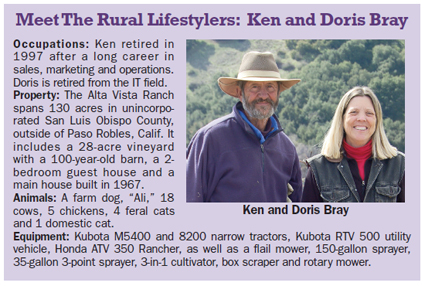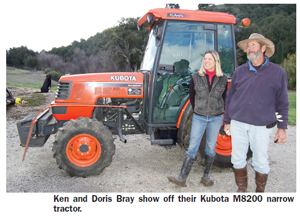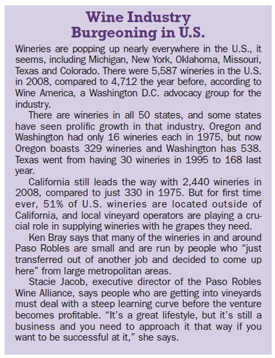"We should have taken Dave with us,” says Doris Bray, relating to an equipment-buying mistake that she and her husband, Ken, made several years ago when starting their new life growing wine grapes.
The mistake was buying a used farm implement that wasn’t designed for what they needed to do. Doris was talking about Dave Merk, their salesman from C&N Tractors in Paso Robles, Calf. — the dealership they’ve grown to rely on for their equipment and service needs.
Today, the Brays dote on 27 acres of wine grapes at the Alta Vista Ranch (AVR) in unincorporated San Luis Obispo County, just outside of Paso Robles. They have two contracts to grow grapes for a winery nearby, and their vineyard is inching toward full production.
The Brays credit their partnership with C&N for making their lifestyle change much easier. Because they can get parts and service in a timely manner, and get trustworthy advice on equipment, the Brays can stick to their farm schedule. The dealership is even helping them sell that implement that they shouldn’t have purchased in the first place.

Welcome to the Ranch
AVR spans 130 acres and includes parcels of 60 and 70 acres. At the turn of the 20th century, the ranch was owned by Julia Hollywood and known as the “Hollywood ranch.” The ranch fell into disrepair and sat unoccupied for nearly 7 years before the Brays purchased it in 1999.
Ken spent 30 years working for companies in Chicago, the East Coast and California. While in San Francisco, he was vice president of strategic planning for a company involved in the wine and spirits business.
In 1997, Bray decided he’d had enough of the corporate world and he retired early. He and his wife, Doris, had been traveling up to the Paso Robles area for a couple of years to go to the local wine festival, and after growing attached to the region they decided they wanted to move there. A real estate agent showed them an old almond orchard with excellent vineyard potential, and they were hooked.
AVR has two vistas — A and B. Vista A 8.5 acres and was planted in April 2003. Vista A’s four separate blocks have vines for Zinfandel, Syrah and Petite Sirah grapes.
Totaling 18 acres, Vista B was planted in late 2005 and is also divided into four blocks — the largest of which contains the relatively rare DuPratt clone of Zinfandel as well as Mourvedre and Grenache Noir grapes and the highly desirable Tannat variety.
The Brays talked about hobby farming as an activity so they could “lay back and take it easy,” Ken says. But that’s not how it turned out.
They signed a contract in 2003 to grow grapes for Four Vines Winery of Paso Robles. After planting and raising their first 8.5 acres and taking their first harvest in 2006, the couple was getting well over the standard $800-per-ton price for Zinfandel grapes because of their farming strategy and their location — on a hillside on the west side of town, facing the sun, which helps mature the fruit.
Four Vines then offered the couple a second contract, and another 18 acres was added to the vineyard in 2005. The first harvest from that planting was last year. The vineyard isn’t quite producing income for the Brays yet, but the signs are encouraging. “We might even make a little money,” this year, Ken says.
Getting the Job
Done Ken and Doris not only had to learn the subtleties of wine grape growing, but also how to operate and maintain their vineyard and acquire the kind of equipment they needed to get the job done. Growing up in suburban Detroit, Ken’s only agricultural experience was picking potatoes from a farm behind his house as a child for 50 cents a bushel.
One of the first tasks Ken and Doris tackled was mowing. Ken’s first tractor purchase in 2000 was a Kubota M5400 and a Gearmore rotary mower from Merk at C&N. It was the start of a long relationship between the Brays and Merk, whose family also had a long history of growing grapes in California’s Central Valley.
 Before visiting Merk, Ken went to a John Deere dealership and a salesman tried to sell him a crawler, which he could not afford. Ken’s says his experience with Merk was different. “David came out with a used tractor, a rental return,” he says. He rigged the tractor to work the vineyard’s steep hills, “and he came out and gave me lessons. Since that time, I’ve added a bucket loader to the front.”
Before visiting Merk, Ken went to a John Deere dealership and a salesman tried to sell him a crawler, which he could not afford. Ken’s says his experience with Merk was different. “David came out with a used tractor, a rental return,” he says. He rigged the tractor to work the vineyard’s steep hills, “and he came out and gave me lessons. Since that time, I’ve added a bucket loader to the front.”
Ken uses the M5400 and bucket loader to clean out plant cuttings between the rows of vines in late fall. When paired with his Gearmore rotary mower, the M5400 is used to mow areas with uneven ground that’s prone to having hidden rocks or tree limbs. He says he uses the mower 4 to 5 times a year.
AVR’s vineyard has terraces, but over time, rainwater will wash the upside of the terrace down into lower rows, producing a slant in some spots. For this application, Ken attaches a box scraper to the tractor and varies its pitch to level out uneven ground. He scrapes 4 or 5 times a year.
He also rips the soil between the rows to assure water permeates into the ground. The scraper gets used 4 or 5 times a year. “Compaction is a major concern in vine- yards,” he says. “If the soil gets compacted, the runoff is significant.”
Precision is a Must
Not every tractor works for every vineyard chore. When the plants are growing during the summer, the Brays work in tight quarters because the plants spread out. The 10-foot rows with 8 feet between plants, is dramatically reduced during the growing season.
In 2007 the Brays bought a Kubota M8200 narrow tractor. “It has a cab, a radio — I spend all day in that thing,” Ken says. The tractor is rigged with an extra fender to lift the canes up so they don’t get caught in the tractor wheels.
The tractor is used to carry out many other jobs in the vineyard, including mowing between the rows and spraying. Ken uses his 7-foot flail mower — probably his most-used vineyard implement — to chop up pieces of canes that result from pruning during dormancy.
He also uses it to mow the barley that he plants between the rows as a cover crop to control runoff. The flail mower is used 10 to 20 times a year, he says. He also uses a 3-in-1 cultivator at the end of the growing season to turn the soil and control weeds.
When it comes to spraying in a vineyard, precision is absolutely necessary, Ken says. He purchased a Gearmore Air Blast 150-gallon sprayer last year so he can disperse nutrients and spray fungicide to keep white powdery mildew from forming on his crops. It’s probably his most important piece of equipment, and it gets used up to 6 times annually. “You could lose your crop if you don’t spray properly. If you get mildew here, you don’t have a crop.”
Because he needs to be careful, most of his herbicide work is done on the ground, using a 35-gallon, 3-point sprayer a few times a year to control weeds. Late in the spring, buds will start to pop all over the plant. “That’s live tissue, and if you’re spraying a certain chemical it may not kill the plant, but it could have some detrimental impact on the plant’s production,” he says.
The Brays also needed vehicles to get around their vineyard’s hilly terrain to monitor irrigation lines, look over plants or conduct their daily “gopher check.” The Brays have a Honda ATV 350 Ranger and a Kubota RTV that runs on unleaded gas. Ken says the Honda ATV is fast and has a winch that can be used to haul limbs. It’s also good for reaching hard-to-get places on the property. The RTV is more user-friendly and has 4WD, with an excellent braking mechanism.
 “On the RTV you can stop on a dime on a hill,” Ken says. “It runs like a car, which is better for Doris, who prefers it to the ATV.” He says the RTV’s running time is 2 to 4 hours a day.
“On the RTV you can stop on a dime on a hill,” Ken says. “It runs like a car, which is better for Doris, who prefers it to the ATV.” He says the RTV’s running time is 2 to 4 hours a day.
Is it Overkill?
In all, Ken estimates he’s spent $120,000 in the past 5 years acquiring equipment. He says C&N Tractors has provided him some invaluable advice on equipment that saved him money. Recently, he was in the market for a ripper that he planned to use to loosen up the soil between the rows in his vineyard. After talking to a Gearmore representative at a local farm show, Bray says he ordered the piece of equipment he thought was right.
But later, he began questioning himself about the purchase. He talked to C&N’s general manager, Jeff Sponhaltz, who suggested Bray simply add shanks to his box scraper and use that instead. He canceled the order for the new implement. “It cost me nothing and they didn’t get a sale out of it. But it made points with me,” Ken says. “They have actually recommended I not buy certain things because it was overkill.”
Ken tries to get information about equipment from various sources, including ag publications, seminars and special programs through American Vineyard Magazine, where vendors display their gear. He also takes advantage of information available through the Independent Grape Growers of the Paso Robles Area, a local grape-growing association where he serves as a director.
“My sources of information are pretty broad,” he says. “When I go into C&N, I usually know what I’m looking for. Their recommendations may be a certain brand, size or configuration, since they know what my property looks like or what I’m using it for.”
A Card in the Mail?
The Brays haven’t had many bad experiences with dealerships, but they do have some advice for equipment dealers: Communication is important, as well as offering a helping hand when time is of the essence.
Ken says he doesn’t necessarily keep track of service needs for his vehicles, especially in December or January when the vineyard is quiet. Throughout the year, he puts 600- 800 hours on his tractors — a lot more than many rural lifestyle farmers do. A simple reminder from a dealer about scheduling service might be worth the dealer’s time, he says.
“I’d like to get a card in the mail that says ‘Your next maintenance is in ‘x’ number of hours, check to see where you are,’ I’d pop the hood and take a look at it,” Ken suggested.
Time is critical at vineyards, especially around harvest time in September and October. When a winemaker orders harvesting to start, “I’ve got 24 hours to get the crew and bring labor in,” Ken says. “If I have a problem with something, I need instant service, which is why I have Dave’s cell phone number. If I need something from the shop, the moment they open I can get it or they can have it out here.”
‘Understand My Goals’
Ken says good service from a dealer is more than just being well versed in features and benefits of what they’re selling. Good service also means knowing what a rural lifestyler is doing, why they’re doing it and how equipment needs vary among their customers.
And every vineyard operation is different — neighbors may have different farming approaches and equipment.
“You’ve need to know the terrain. You need to understand my goals and understand my farming strategy in order to provide me with advice and recommendations and the service I need,” he says. “It’s getting that salesman or dealership owner to understand what the situation is. Get out from behind your desk and get into the field and walk around with the customer.”





Post a comment
Report Abusive Comment